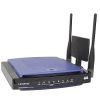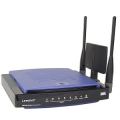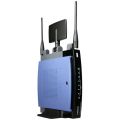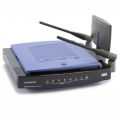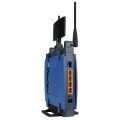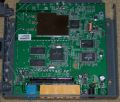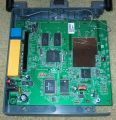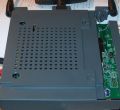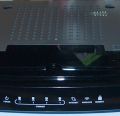Linksys WRT300N v1.1
Linksys WRT300N v1.1
Manuf (OEM/ODM): CyberTAN
FCC approval date: 06 February 2007
Country of manuf.: China
S/N prefix: CNP1
Type: wireless router
FCC ID: Q87-WRT300NV11
IC ID: 3839A-WRT3NV11
Power: 12 VDC, 1 A
Connector type: barrel
CPU1: Broadcom BCM4705L (300 MHz)
FLA1: 8 MiB8,388,608 B <br />65,536 Kib <br />8,192 KiB <br />64 Mib <br />0.00781 GiB <br /> (Samsung K8D6316UBM-PI07)
RAM1: 32 MiB33,554,432 B <br />262,144 Kib <br />32,768 KiB <br />256 Mib <br />0.0313 GiB <br /> (Nanya NT5DS8M16F5-5T × 2)
Expansion IFs: none specified
JTAG: yes, 12-pin header, unpopulated, micro
Serial: yes, 5-pin header, unpopulated, (115200,8,N,1)
WI1 chip1: Broadcom BCM4321
WI1 chip2: Broadcom BCM2055
WI1 802dot11 protocols: bgn
WI1 MIMO config: 2x2:2
WI1 antenna connector: none
ETH chip1: Broadcom BCM4705L
Switch: Broadcom BCM5325E
LAN speed: 100M
LAN ports: 4
WAN speed: 100M
WAN ports: 1
bgn
Stock bootloader: CFE
Stock FW OS: Linux
Default SSID: linksys (50 addl. devices)
Default IP address: 192.168.1.1
the IP 192.168.1.1 is used by 1304 additional devices
of which 154 are Linksys devices
Default login user: blank
Default login password: admin
blank:admin credentials used by 295 additional devices
of which 143 are Linksys devices
802dot11 OUI: 00:1A:70 (9 E, 15 W), 00:1C:10 (9 E, 16 W)
Ethernet OUI: 00:1A:70 (9 E, 15 W), 00:1C:10 (9 E, 16 W)
| CPU1 brand | WI1 chip1 brand | WI1 chip2 brand | |
|---|---|---|---|
| Linksys WRT300N v1.0 | Broadcom | Broadcom | Broadcom |
| Linksys WRT300N v1.1 | Broadcom | Broadcom | Broadcom |
| Linksys WRT300N v2 | Intel XScale | Atheros | Atheros |
For a list of all currently documented Broadcom chipsets with specifications, see Broadcom.
Wireless-N Broadband Router
• Support page • (Template link outdated)
Links
- Listed on the 'Linksys routers' page on Wikipedia
- WRT300N v1.1 - Now supported! - See page 15 @ DD-WRT
- Linksys WRT300N v1.1 JTAG @ DD-WRT
Flashing
| NOTE: During configuration or flashing a device, the only things that should be hooked to the device is the computer and power. |
Flashing DD-WRT
| WARNING: Do not flash micro this unit! |
| WARNING: Requires K2.4 for DD-WRT, Do not flash anything else! |
- Download DD-WRT v24 Mini from this link: dd-wrt.v24_mini_wrt300nv11.bin
- Read the peacock announcement found here: viewtopic.php?t=51486
- Do a proper Hard reset or 30/30/30 on your router.
- Set your computer to a static IP address of 192.168.1.7 Subnet mask to 255.255.255.0
- Plug a lan cable from your computer to a LAN port on the router. Disable any wireless on your computer
- Open your web browser to 192.168.1.1
- Find any settings you might want to keep and copy them down or cut and paste them
(e.g. MAC addresses for MAC filtering) - Go to Administration, Firmware upgrade, in the linksys webgui.
- Browse to the dd-wrt.v24_mini_wrt300nv11.bin you downloaded, and hit upgrade.
- Wait until you can access the dd-wrt webgui at 192.168.1.1
- Power cycle the router
- Wait until you can access the dd-wrt webgui at 192.168.1.1
- Do ANOTHER Hard reset or 30/30/30 on the router.
- Go in and set your user name and password by carefully typing each of them in.
- Set your computer to auto IP and auto DNS.
Upgrading
Updating DD-WRT
If dd-wrt is already on the router follow these instructions. If stock firmware is on the router follow the flashing instructions.
- Check for recommended builds here first.
- Set your computer to a static IP of 192.168.1.7. (or to whatever subnet the router is on) Disable all firewalls and security. Disable wireless on your computer and only have the router connected to the flashing computer by the ethernet cable between the two.
- Hard reset or 30/30/30 (If the router supports it, if not, reset to defults in the GUI) prior to flashing. Wait. Check for password page on re-login and change password.
- Flash firmware. You can use the webgui except if you have a belkin router. (For belkin use tftp.exe to flash)
- Wait...at least three minutes. Lights should return to normal. See important2, below. Failing to wait is how most people brick their routers.
- Do a power cycle of the router. (Unplug the cord, count to 30 and plug it back in.)
- Wait for the lights to return to normal usually about 2 minutes.
- Hard reset or 30/30/30 again (If the router supports it, if not, reset to defults in the GUI). Wait. Check for the password page and re-login to change the password. Then you can reconfigure your settings manually.
- Once configured set your computer back to autoIP and autoDNS.
Important1: This Hard reset or 30/30/30 works fine for Asus router, but you do have to power cycle after the reset.
Important2: After you flash the firmware, and before you do the hard reset, the router will be building some nvram settings. YOU MUST WAIT FOR THIS TO FINISH PRIOR TO DOING ANYTHING WITH THE ROUTER INCLUDING A HARD RESET. Usually, you can tell when this process is completed by the WAN light coming on, but it does take several minutes. Go have a beer. There are starting to be more and more people who BRICK their routers by not waiting until the nvram is rebuilt, PRIOR to doing a hard reset. YOU NEED TO WAIT!
JTAG-Serial Info
JTAG
JTAG Pinouts
nTRST 1o o2 GND TDI 3o o4 GND TDO 5o o6 GND TMS 7o o8 GND TCK 9o o10 GND nSRST 11o o12 N/C
JTAG Recovery
- JTAG Recovery Instructions
Serial
Serial Pinouts
JP2
VCC 1 o (3.3 volts)
RX 2 o
TX 3 o
N/C 4 o
GND 5 o (This is the pin closest to where it
states CB1 on the board on a Ver1.1)
Hyper terminal Setup in Windows XP
In Windows XP, Click Start Button - All Programs - Accessories -
Communication - HyperTerminal
Enter a name for the connection, Click ok
Choose com port you adapter is plugged into, Click ok
Set:
Bits per second = 115200
Data Bits = 8
Parity = none
Stop bits = 1
Flow control = none
Click ok
Click File - Save As, and select a place to save it to so you
don't have to enter the settings again.
Putty Setup in Windows XP
After installing putty, run it Serial line = The COM port your using for serial (ie. COM3) Speed = 115200 Click on Serial under Connection Serial line to connect to = same as above (Serial line) Speed (baud) = 115200 Data bits = 8 Stop bits = 1 Parity = none Flow control = none Click Session Enter a name for your connection under saved sessions Click Save Click Open
DD-WRT Serial Recovery
Modified redhawk0 instructions
- Print out these instructions for Off-Line use
- Connect PC to router with a network cable
- Configure PC with a static IP of 192.168.1.10
- Connect Serial cable
- Start one of the programs from above
- Get TFTP ready with file selected
- Use dd-wrt.v24_mini_wrt300nv11.bin
- Connect power to the router
- start a rapid fire Cntl-C as you plug the router to power
- type "nvram erase" w/o quotes, hit enter
- type "flash -noheader : flash1.trx" w/o quotes, this starts the tftp daemon, hit enter
- but have TFTP ready
- Click go or start on TFTP
- give it 5 minutes after it finishes
- then power cycle....Hard reset or 30/30/30...then config
- when it stops spitting out txt....hit the enter key...you should get a login prompt...
- at that point, power cycle it, hard reset...then config - you'll see it boot up
vlan Info
DD-WRT vlan Info
Pictures
Notes
DD-WRT Notes
DD-WRT Debricking information
Here is a thread which contains a JTAG method for debricking your WRT300N v1 and v1.1 model.
For further information about JTAG please see the wiki entry entitled JTAG.
- Linksys 300N - Bricked due to no power cycle (Solved)
- Bricked wrt300n v1.1 power went out during upgrade
DD-WRT Post-Installation
Once you have completed all of the steps above, your router is already set and ready to be used, configured, etc.
Known DD-WRT Issues
- Versions 1.0 and 2.0 of this router have 4MB flash, so JFFS will not work with the standard distros.
- Version 1.1 has 8MB of flash so may (untested) work with JFFS.
- I use static DHCP for my network and found that this page had strange errors (incorrect labels, missing radio buttons).
- To fix this, navigate to Administration -> Factory Defaults and then restore the factory defaults to the router.
- Relatively same issue with MAC filtering where the word "error" replaced labels.
- When editing settings on the Administration page for the first time (after flash or hard reset),
- make sure that you change the interface language dropdown to Simplified Chinese, then back to English.
- Otherwise the router will end up in Simplified Chinese until you either change it, or hard reset the router.
- If you did not hard reset the router before you installed DD-WRT, then the login information is as follows:
- Username: root
- Password: Whatever your password was
- Hard reset the router if you cannot figure out the login information.
- Refer here ([dd-wrt-wiki:Linksys WRT300N#General Information]) for the default login information.
- Occasionally after changing a setting, the router will lose its connection to the internet.
- All you need to do to restore the connection is navigate to the Administration page and scroll
- to the bottom and hit the Reboot Router button.
- I recommend that you change all the settings you want to change then reboot the router regardless.
DD-WRT Security LED
- The security LED will not light up after flashing on version 1.1. To fix this, go to
- Administration > Commands, type in the following and then click Save Startup:
while sleep 1; do if [ `nvram get wl0_security_mode` = "disabled" ]; then gpio enable 3; else gpio disable 3; fi; done &
As posted by osmosis
On the wiki for 150N is posted
root@DD-WRT:~# gpio enable 5 #(SECURITY LED - off - green) root@DD-WRT:~# gpio disable 5 #(SECURITY LED - on - green) root@DD-WRT:~# gpio disable 3 #(SECURITY LED - on - amber) root@DD-WRT:~# gpio enable 3 #(SECURITY LED - off - amber)
this applies for the WRT300N v1.0 as well so to incorporate the amber into the mix as not secure:
- Also confirmed working on the WRT300N v1.1 DarkShadow talk contribs 02:40, October 1, 2010 (UTC)
while sleep 1; do if [ `nvram get wl0_security_mode` = "disabled" ]; then gpio enable 5 gpio disable 3 else gpio enable 3 gpio disable 5 fi done &
